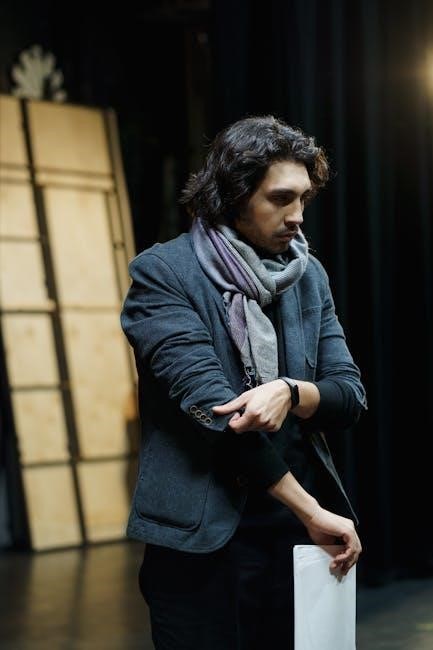
“An Actor Prepares” by Konstantin Stanislavski is a foundational guide for actors, offering insights into psychological preparation, emotional recall, and theatrical reality. This PDF remains a vital resource for mastering authentic performances.
Overview of the Book and Its Importance
“An Actor Prepares” by Konstantin Stanislavski is a seminal work that outlines the psychological and technical foundations of acting. Written nearly a century ago, it remains a cornerstone of actor training, emphasizing the importance of understanding theatrical reality, emotional recall, and the actor’s personal experiences. The book introduces Stanislavski’s system, which has profoundly influenced modern acting techniques. Its accessible format, including exercises and practical advice, makes it indispensable for both novice and experienced actors. Available as a PDF, the book continues to be widely studied, offering insights into the craft of acting and the preparation required for authentic performances. Its enduring relevance underscores its importance in the world of theater and film.
Why Every Actor Should Read “An Actor Prepares”
“An Actor Prepares” is essential reading for actors seeking to deepen their craft. Stanislavski’s timeless techniques, such as emotional recall and theatrical reality, empower actors to deliver authentic performances. The book’s practical exercises and psychological insights help actors connect with their roles on a profound level. Its focus on preparation and understanding the character’s motivations ensures a comprehensive approach to acting. Whether for stage or screen, this guide remains indispensable, offering tools to transform raw talent into compelling, believable portrayals. Its influence on modern acting techniques underscores its relevance, making it a must-read for actors at all career stages.

Konstantin Stanislavski and His Acting System
Konstantin Stanislavski revolutionized acting with his groundbreaking system, emphasizing authenticity and emotional depth. His approach, detailed in “An Actor Prepares,” remains a cornerstone of modern acting techniques.
The Core Principles of Stanislavski’s Method
Stanislavski’s method centers on creating authentic performances through emotional truth. Key principles include the “magic if,” emotional recall, action, and given circumstances. Actors are encouraged to explore their characters’ motivations and emotions deeply, using personal experiences to connect with the role. The concept of the “superobjective” helps actors understand their character’s overarching goal, while “beats” break scenes into manageable emotional shifts. Stanislavski also emphasized the importance of physicality and vocal training to fully embody a character. His approach fosters a disciplined yet intuitive process, allowing actors to craft compelling, believable performances. These principles form the foundation of modern acting techniques, making Stanislavski’s work timeless and universally applicable.
How the System Has Influenced Modern Acting Techniques
Stanislavski’s method has profoundly shaped modern acting, inspiring techniques like Method Acting, popularized by Lee Strasberg. His emphasis on emotional truth and personal experience influenced actors like Marlon Brando and Daniel Day-Lewis. The approach of breaking scripts into “beats” and analyzing “given circumstances” is now standard in actor training. Stanislavski’s focus on physicality and vocal work has also evolved into practices like biomechanics. Contemporary actors adapt his principles to film, where authenticity is crucial. His legacy lies in empowering actors to craft nuanced, believable performances, ensuring his system remains a cornerstone of acting craft across genres and mediums, continuing to inspire new generations of performers.

Key Concepts from “An Actor Prepares”
The book introduces foundational ideas like imagination, theatrical reality, and emotional recall. It emphasizes concentration, the “magic if,” and transforming experiences into authentic performances, guiding actors to deeper connections with roles.
The Role of Imagination in Acting
In “An Actor Prepares,” Stanislavski highlights imagination as a vital tool for creating authentic performances. He argues that actors must cultivate their ability to envision scenarios, emotions, and characters’ lives beyond the script. This concept, known as the “magic if,” encourages actors to ask themselves how they would feel or act in hypothetical situations. Imagination allows actors to transform personal experiences into the character’s reality, fostering depth and believability. Stanislavski emphasizes that imagination should not be arbitrary but rooted in logical thinking and emotional truth. He provides practical exercises to develop this skill, such as visualizing sensory details or creating backstories. By harnessing imagination, actors can bridge the gap between their own lives and the roles they portray, leading to more compelling and truthful performances.
Understanding Theatrical Reality vs. Real Life
In “An Actor Prepares,” Stanislavski distinguishes between theatrical reality and real life, emphasizing that the stage requires a heightened form of truth. Theatrical reality is not a direct mirror of life but rather a stylized and exaggerated version designed to engage the audience emotionally. Stanislavski explains that actors must adapt their performances to the demands of the stage, where every action and emotion must be clear and impactful. He encourages actors to create a believable illusion, not by replicating real life but by crafting a reality that serves the play’s dramatic structure. This understanding helps actors bridge the gap between their personal experiences and the heightened demands of performance, ensuring authenticity within the theatrical context.
Concentration and Emotional Recall Techniques
Stanislavski’s method emphasizes the importance of concentration and emotional recall as essential tools for actors. Concentration involves focusing entirely on the scene’s action and the other actors, ensuring authenticity in performance. This technique helps actors stay present and responsive, avoiding distractions. Emotional recall, on the other hand, is a process where actors access personal experiences to connect with the emotions required for a role. By revisiting vivid memories, actors can genuinely portray feelings, making their performances more compelling and believable. These techniques work together to create a natural and engaging portrayal of a character, fostering a deeper connection with the audience.

The Process of Preparing for a Role
Stanislavski’s approach details a systematic method to prepare for roles, emphasizing research, analysis, and emotional connection to create authentic performances.

Research and Analysis: Laying the Foundation
Stanislavski emphasizes that preparation begins with thorough research and analysis. Actors must delve into the script, understanding the character’s background, motivations, and emotional layers. This involves studying the historical context, social environment, and cultural nuances to create authenticity. By breaking down the script into beats and actions, actors can identify key moments that reveal character traits. Analysis also extends to understanding the playwright’s intent and the overall themes of the play. This foundational work allows actors to connect deeply with their roles, ensuring their performances are rooted in truth and precision. Effective research and analysis transform the actor into an active interpreter of the text, enabling them to embody the character fully.
Creating a Character Handbook
Stanislavski advocates for creating a detailed character handbook to guide the actor’s journey. This document includes the character’s physical traits, backstory, motivations, and emotional journey. It also outlines specific mannerisms, speech patterns, and relationships with other characters. The handbook serves as a reference point, ensuring consistency in performance. Actors are encouraged to fill it with notes, images, and insights gathered during research. This tool helps bridge the gap between the actor’s life and the character’s reality. By documenting every detail, actors can make intentional choices that align with the character’s truth. This process fosters a deep connection, allowing the actor to inhabit the role fully and authentically. The handbook becomes a vital resource throughout rehearsals and performances.
Rehearsal Techniques and Emotional Preparation
Stanislavski emphasizes the importance of structured rehearsals to cultivate a character’s depth. He introduces techniques like “sense memory” and “affective memory” to connect actors with their emotions authentically. Sense memory involves recalling sensory experiences to evoke genuine feelings, while affective memory taps into personal emotional experiences. These methods help actors access and express emotions truthfully during performances; Additionally, Stanislavski advocates for the “Magic If,” encouraging actors to imagine themselves in the character’s circumstances. This fosters empathy and understanding, enabling a deeper connection to the role. Rehearsals become a space for exploration, where actors refine their emotional responses and build consistency. Through these practices, actors transform into their characters, delivering compelling and believable portrayals.

Psychological Aspects of Acting
Stanislavski explores the psychological depth of acting, focusing on understanding character motivations and emotions. He emphasizes the importance of mental discipline and authenticity in performance, enabling actors to embody roles convincingly.
Understanding Theatrical Reality
In “An Actor Prepares,” Stanislavski delves into the concept of theatrical reality, distinguishing it from real-life experiences. Theatrical reality refers to the crafted, believable world created on stage, where actors and audiences collectively suspend disbelief. Stanislavski emphasizes that actors must fully inhabit this reality, ensuring their actions and emotions align with the fictional circumstances. This requires a deep psychological connection to the character’s experiences, allowing the audience to engage emotionally. Theatrical reality is not about mimicry but about creating a shared, immersive experience that feels authentic within the bounds of the performance. This concept is central to Stanislavski’s method, helping actors bridge the gap between their own lives and the characters they portray.

Breaking Down the Role into Manageable Parts
Stanislavski advocates for dividing a character’s role into smaller, manageable components to ensure a comprehensive understanding and authentic portrayal. He suggests identifying key tasks, actions, and beats within the script, allowing actors to focus on specific objectives. By breaking down the role, actors can explore their character’s motivations, desires, and emotional journeys in depth. This systematic approach helps in creating a cohesive and believable performance. It also enables actors to tackle complex roles without feeling overwhelmed, ensuring clarity and precision in their preparation. This method is a cornerstone of Stanislavski’s system, empowering actors to craft nuanced and compelling characters.

Practical Tips for Actors
- Maintain physical fitness to enhance stamina and expression.
- Practice vocal exercises daily for clarity and projection.
- Develop a consistent pre-show routine to focus mentally.
- Analyze scripts thoroughly, marking beats and intentions.
- Engage in emotional recall exercises to access deeper feelings.
- Stay adaptable to director feedback and changing dynamics.
How to Handle Director’s Instructions Effectively
To effectively handle a director’s instructions, actors must first listen actively and ask clarifying questions to ensure understanding. Maintaining open communication fosters trust and collaboration. Be adaptable and open to feedback, as directors often see the bigger picture. Focus on the overall vision while incorporating specific notes into your performance. Avoid taking criticism personally; instead, view it as a tool for growth. Practice translating instructions into actionable steps, whether it’s adjusting tone, pacing, or physicality. Finally, reflect on how the feedback aligns with your character’s arc and the play’s themes. This approach ensures your performance remains aligned with the director’s vision while staying true to your artistic process.
Staying Organized and Focused During Preparation

Staying organized and focused during preparation is crucial for actors to delve deeply into their roles. Create a structured plan, breaking down the script into manageable sections and setting clear goals for each rehearsal. Use tools like calendars or to-do lists to track progress and deadlines. Establishing a daily routine, including time for research, physical exercises, and emotional preparation, helps maintain consistency. Minimize distractions by designating a quiet, organized workspace. Practice mindfulness or meditation to enhance concentration and reduce stress. Regularly review and adjust your preparation strategy to ensure alignment with the role’s demands. This disciplined approach fosters clarity and allows actors to fully immerse themselves in their characters, leading to a more authentic and compelling performance.

Modern Applications of Stanislavski’s Techniques
Stanislavski’s methods are widely applied in contemporary acting, enhancing performances in film, theater, and television. His emphasis on emotional authenticity and detailed character analysis remains invaluable, guiding actors to create nuanced, believable portrayals that resonate with modern audiences.
How Contemporary Actors Use His Methods
Contemporary actors widely embrace Stanislavski’s techniques, adapting them to modern acting challenges. Many blend his system with other methods, creating a hybrid approach that suits diverse performances. Emotional recall and action analysis remain central, helping actors connect deeply with their roles. Physicality and improvisation are also integrated, allowing for dynamic character development. Actors often create detailed character backstories and research historical contexts to enrich their portrayals. Stanislavski’s emphasis on authenticity ensures that performances remain heartfelt and relatable, even in today’s fast-paced, technologically driven industry. His methods continue to inspire actors to explore their creativity and deliver compelling, truthful performances across film, theater, and television.
Adapting the Techniques for Film and Theater
Stanislavski’s methods are highly adaptable to both film and theater, though their application differs. In theater, actors rely on sustained energy and physicality, as performances are live and immersive. Film, however, demands subtlety and precision, with emotions conveyed through close-ups and nuanced expressions. Techniques like emotional recall and action analysis remain essential but are scaled to fit the medium. For film, actors focus on internal truth, while theater emphasizes external expression. The core principles of Stanislavski’s system—authenticity, imagination, and concentration—remain consistent, ensuring powerful performances regardless of the medium. This versatility highlights the enduring relevance of his teachings in modern acting.
“An Actor Prepares” remains a cornerstone of acting literature, offering timeless wisdom for performers. Stanislavski’s holistic approach emphasizes authenticity, emotional depth, and mental discipline, providing actors with tools to craft compelling characters. The book bridges the gap between theory and practice, making it invaluable for both novices and seasoned professionals. Its insights into imagination, concentration, and psychological exploration continue to inspire actors across stage and screen. By focusing on the actor’s inner process, Stanislavski’s method ensures performances that resonate deeply with audiences. This guide not only elevates the craft but also empowers actors to embrace their creativity and vulnerability, ensuring its relevance for generations to come.
Leave a Reply
You must be logged in to post a comment.